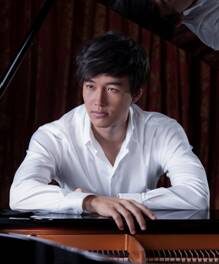Parisian salons were hotbeds for contemporary music during the time period covered by three French composers featured in the third concert of the Carolina Summer Music Festival. The intimate and resplendent surroundings of the venue, the Jon Kuhn Gallery, evoked much of the ambience and excitement of that era. Only 100 music lovers were fortunate enough to attend; they were seated within a narrow, roughly rectangular space and surrounded by the play of prismatic colored lights from the rotating, free-standing and wall-mounted glass sculptures of the internationally-known artist.
The composer of the last work on the program, Gabriel Fauré (1845-1924), taught both composers featured on the first half of the concert. Composer and flutist Phillipe Gaubert (1879-1941) joined Fauré on the faculty of the Paris Conservatoire and was an active conductor. Maurice Ravel (1875-1937) entered the school as a piano major but Fauré convinced him to switch to composition.
My focus is biased toward strings and opera so Gaubert, a prolific composer of works for the flute, was a name new to me. His charming Trois Aquarelles (Three Watercolors), for flute, cello, and piano (1915), exploits the differences between the instruments more than their ability to blend. In the first movement, “Par un clair matin,” the flute’s wake-up call is accompanied by the piano’s scurrying arpeggios, suggesting beams of the morning sun. “Soir d’automme” gives each instrument a featured episode, such as a soaring episode for flute or a dark, brooding solo for the cello. Spanish castanets are suggested during the last movement, “Sérénade,” which has a tinge of the Middle East. Flutist Elizabeth Ransom played with a firmly-focused and warm tone while cellist Grace Lin Anderson produced a full, rich sound from the middle and lower range of her instrument. Pianist Ināra Zandmane, with the instrument’s lid fully up, produced sound of the most refined dynamics along with a wide kaleidoscope of color. It is hard to believe Gaubert composed this beguiling work while he was in the trenches of WWI!
The many early failures of the Portuguese, French, and British successfully to colonize Madagascar inspired the text of Ravel’s gorgeous Chansons madécasses, for soprano, flute, cello, and piano (1915). The composer drew upon alleged “translations” of native poems by Évariste Parney (1753-1814), and their explicit sexuality and anti-imperialist political sentiments caused some members of the audience at the June 16, 1926, premiere to walk out. (Elizabeth Sprague Coolidge had commissioned the work in 1925.) The first song, “Nahandove,” paints love-making in the moonlight, followed by “Aoua!,” with its anguished warning against white men. The set ends with the languorous “Il est doux.” The vocal part has been taken by sopranos and baritones. Mezzo-soprano Mary Siebert sang the words with extraordinary clarity and a warm tone. Perhaps the dry humidity caused slight flaws in two sustained notes in the first song. Her upper range was more than adequate for the startling forte opening of the second song, which was delivered with precision. The accompanying, constantly shifting chimera of sound was perfectly captured by her colleagues, flutist Ransom, cellist Anderson, and pianist Zandmane.
Fauré’s first Piano Quartet, in C minor, Op. 15 (1879), is the composer’s most popular chamber music work, and it received an outstanding performance from the festival’s musicians. Pianist Zandmane’s control of the spectrum, from a hushed pp to forte, combined with the rich variety of her timbre, was breathtaking. She was joined by violinist Jacqui Carrasco, violist Diane Phoenix-Neal, and cellist Anderson. All three produced a full, warm string tone, and the composer gave each an opportunity to step into the spotlight. Balance and ensemble were extraordinary, especially in the opening of the first movement, which can and often does sound too thick, even when played by touring piano quartets. The delicate, gossamer second movement is my favorite part of the work, thanks to what Melvin Berger, in his Guide to Chamber Music, calls “a wispy (piano) melody over light pizzicato chords in the strings.” The melancholy adagio is followed by a finale with a rhythmic pattern suggestive of the first movement; it ends brilliantly. This superb interpretation deserved its standing ovation.
Preceding the performance, sculptor Jon Kuhn shared some important news and announced a gift for every member of the audience. Many music lovers will remember the Steinway & Sons’ Legendary Pianos Tour. Its last stop at Meredith College in November 2002 featured unique pianos that had belonged to famous virtuosi. Several of those were examples of “art pianos” in which an artist is allowed to customize outstanding instruments. Kuhn is doing this with the outstanding Viennese company, Bösendorfer. The Kuhn-Bösendorfer #1 half concert grand Model 225 will soon arrive in the gallery.
The free gift was a hardbound volume, Jon Kuhn: The Story of a Glass Sculpture, by James Yood. Late in the day on September 11, 2001, the Medical Director of Forsyth Regional Cancer Center Elms Allen called Kuhn. Their conversation led to the commission of “Hope and Healing,” a glass sculpture now on display in the center. The book documents every stage of its creation.











